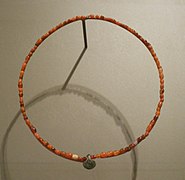Necklace
hideThis article has multiple issues. Please help or discuss these issues on the talk page. (Learn how and when to remove these template messages)
|

A necklace is an article of jewellery that is worn around the neck. Necklaces may have been one of the earliest types of adornment worn by humans.[1] They often serve ceremonial, religious, magical, or funerary purposes and are also used as symbols of wealth and status, given that they are commonly made of precious metals and stones.
The main component of a necklace is the band, chain, or cord that wraps around the neck. These are most often rendered in precious metals such as gold, silver, and platinum. Necklaces often have additional attachments suspended or inset into the necklace itself. These attachments typically include pendants, lockets, amulets, crosses, and precious and semi-precious materials such as diamond, pearls, rubies, emeralds, garnets, and sapphires. They are made with many different type of materials and are used for many things and sometimes classed as clothing.
Historical Necklaces[]

Prehistoric neckware[]
Prehistoric peoples often used natural materials such as feathers, bone, shells, and plant materials to create necklaces, but by the Bronze Age metallic jewellery had replaced pre-metallic adornments.[2] Necklaces were first depicted in the statuary and art of the Ancient Near East, and early necklaces made of precious metals with inset stones were created in Europe.[3]

Ancient civilizations[]
In Ancient Mesopotamia, cylinder seals were often strung and worn as jewellery.[4] In Ancient Babylon, necklaces were made of carnelian, lapis lazuli, agate, and gold, which was also made into gold chains.[5] Ancient Sumerians created necklaces and beads from gold, silver, lapis lazuli and carnelian.[5] In Ancient Egypt, a number of difference necklace types were worn. Upper-class Ancient Egyptians wore collars of organic or semi-precious and precious materials for religious, celebratory, and funerary purposes.[6] These collars were often ornamented with semi-precious, glass, pottery, and hollow beads.[3] Beads made from a variety of precious and semi-precious materials were also commonly strung together to create necklaces.[7] Gold that was fashioned into stylised plant, animal, and insect shapes were common as well. Amulets were also turned into necklaces.[8] In Ancient Crete necklaces were worn by all classes; peasants wore stones on flax thread while the wealthy wore beads of agate, pearl, carnelian, amethyst, and rock crystal.[3] Pendants shaped into birds, animals, and humans were also worn, in addition to paste beads.[3]

In Ancient Greece, delicately made gold necklaces created with repoussé and plaited gold wires were worn.[3] Most often these necklaces were ornamented with blue or green enameled rosettes, animal shapes, or vase-shaped pendants that were often detailed with fringes.[3] It was also common to wear long gold chains with suspended cameos and small containers of perfume.[3] New elements were introduced in the Hellenistic period; colored stones allowed for poly-chromatic pieces, and animal-head finials and spear-like or bud shaped pendants were hung from chains.[5] Ancient Etruscans used granulation to create granulated gold beads which were strung with glass and faience beads to create colorful necklaces.[5] In Ancient Rome necklaces were among the many types of jewellery worn by the Roman elite. Gold and silver necklaces were often ornamented with foreign and semi-precious objects such as amber, pearl, amethyst, sapphire, and diamond.[9] In addition, ropes of pearls, gold plates inset with enamel, and lustrous stones set in gold filigree were often worn.[3] Many large necklaces and the materials that adorned the necklaces were imported from the Near East .

Later in the empire, following barbarian invasions, colorful and gaudy jewellery became popular.[9] In the Byzantine era, ropes of pearls and embossed gold chains were most often worn, but new techniques such as the use of niello allowed for necklaces with brighter, more predominant gemstones .[3] The Early Byzantine Era also saw a shift to distinctly Christian jewellery which displayed the new Christian iconography.[5]
Timeline of non-classical European necklaces[]
2000 BC – AD 400: Bronze amulets embossed with coral were common.[3] In Celtic and Gallic Europe, the most popular necklace was the heavy metal torc, made most often out of bronze, but sometimes out of silver, gold, or glass or amber beads.[5]

AD 400 - 1300: Early European barbarian groups favored wide, intricate gold collars not unlike the torc.[10] Germanic tribes often wore gold and silver pieces with complex detailing and inlaid with colored glass and semi-precious stones, especially garnet.[5] Anglo-Saxon and Scandinavian groups worked mainly in silver, due to a deficit of gold, and wrought patterns and animal forms into neck-rings. In the Gothic period necklaces were uncommon, though there are a few records of diamond, ruby, and pearl necklaces.[10] It was not until the adoption of lower necklines later in the Middle Ages that necklaces became common.
1400 – 1500: During the Renaissance it was fashionable for men to wear a number of chains, plaques, and pendants around their necks, and by the end of the 15th century the wealthiest men would wear great, shoulder covering collars inlaid with gems.[3] Women typically wore simpler pieces, such as gold chains, or strung beads or pearls.[10] By the end of the period, larger, more heavily adorned pieces were common among the wealthy, particularly in Italy.[10]
1500–1600: Long pearl ropes and chains with precious stones were commonly worn.[3] In the latter half of the century, natural adornments, such as coral and pearl, were joined with enamel and metals to create intricate pendants.[11] Heavily jeweled, delicately framed cameo pendants were popular as well.[10] Chokers, last worn commonly in antiquity, also made a resurgence at this time.[5]
1600–1700: Few men in the Baroque period wore jewellery, and for women necklaces were unsophisticated, often a simple strand of pearls or delicately linked and embellished strands of metal with small stones.[3][5] Later in the century, after the invention of new diamond cutting techniques, priority was for the first time given to the jewels themselves, not their settings; it was common for jewels to be pinned to black velvet ribbons.[10] Miniatures also grew in popularity, and were often made into portrait pendants or lockets.[5]
1700–1800: Portrait pendants were still worn, and in extravagantly jeweled settings.[5] The newly wealthy bourgeoisie delighted in jewellery, and the new imitation stones and imitation gold allowed them more access to the necklaces of the time.[5] In the early part of the century, the dominant styles were a velvet ribbon with suspended pendants and the rivière necklace, a single row of large precious stones surrounded by other precious stones.[5] By mid-century colorful, whimsical necklaces made of real and imitation gems were popular, and the end of the century saw a neo-Classical resurgence.[5] In the Age of Enlightenment gowns often featured a neck ruffle which women accented with neck ribbons rather than traditional necklaces, but some women did wear chokers inlaid with rubies and diamonds.[3] Seed pearls were introduced to the United States during the Federalist Era, leading to an increase in lacy pearl necklaces.[12]
1800–1870: The low necklines of the court gowns fashionable at this time led to the use of large necklaces set with precious jewels.[3] In Napoleon's court that ancient Greek style was fashionable, and women wore strands of pearls or gold chains with cameos and jewels.[10][13] In the Romantic period necklaces were extravagant: it was fashionable to wear a tight, gem-encrusted collar with matching jewel pendants attached and rosettes of gems with pearl borders.[3] It was also common to wear jeweled brooches attached to neck ribbons.[3] Some necklaces were opulent that they made to be dismantled and reconfigured into a shorter necklace, brooches, and a bracelet.[10] Highly embellished Gothic style necklaces from England reflected the crenelations, vertical lines and high relief of the cathedrals.[10] Empress Eugénie popularised bare décolletage with multiple necklaces on the throat, shoulders, and bosom.[3] There was also an interest in antiquity; mosaic jewellery and Roman and Greek necklaces were reproduced.[5] Machine-made jewellery and electroplating allowed for an influx of inexpensive imitation necklaces.[10]
1870–1910: The Edwardian era saw a resurgence of pearl necklaces, in addition to a dog-collar style of necklace made of gold or platinum with inset diamonds, emeralds, or rubies.[3] The Art Nouveau movement inspired symbolic, abstract designs with natural and animal motifs.[5] The materials used - glass, porcelain, bronze, ivory, mother of pearl, horn, and enamel - were not used for their value, but for their appearance.[10][5]
1910–1970: Chanel popularised costume jewellery, and ropes of glass beads were common. The Art Deco movement created chunky, geometric jewellery that combined multiple types of gems and steel.[5] By the 1960s costume jewellery was widely worn, which resulted in seasonal, ever-changing styles of necklaces and other jewellery.[3] Real jewellery that was common in this period included wholly geometric or organically shaped silver necklaces, and precious gems set in platinum or gold necklaces inspired by the time of the French Empire.[3] Love beads (a single strand of stone or glass beads) and pendant necklaces (most often made of leather cords or metal chains with metal pendants) became popular and were worn mostly by men.[3]
Shell necklaces[]
Aboriginal Tasmanian women have been making shell necklaces from maireener (Phasianotrochus irisodontes)shells for at least 2,600 years, with some major collections in museums. The continuation of the practice is being threatened by reducing supply, and sixth-generation Palawa woman Lola Greeno is concerned that the practice will die out.[14][15]
Court Necklace[]
In Qing dynasty China, court necklace, also called chao zhu (朝珠), was worn by the Qing dynasty emperors and other members of the imperial family. The court necklace originated from a Buddhist rosary sent in 1643 by the Dalai Lama to the first emperor of Qing. The necklace is composed of 108 small beads, with 4 large beads of contrasting stones to symbolize the 4 seasons and was placed between groups of 27 beads. The necklace was also practical as it could be used for mathematical calculations in the absence of an abacus.[16]

Chao zu, Court necklace, Qing dynasty

Chao zu, Court necklace, Qing dynasty.
Necklace lengths[]
Necklaces are typically classified by length:[17]

- Collar
- A collar is about 30 centimetres (12 inch) to 33 centimetres (13inch) long and sits high on the neck.
- Choker
- A choker is a close-fitting, short necklace, 35 centimetres (14 in) to 41 centimetres (16 in) long.
- Princess necklace
- A princess necklace is 45 centimetres (18 in) to 50 centimetres (20 in) long.
- Matinee necklace
- A matinee length necklace is 56 centimetres (22 in) to 58 centimetres (23 in) long.
- Opera necklace
- An opera necklace is 75 centimetres (30 in) to 90 centimetres (35 in) long and sits at the breastbone.
- Rope necklace
- A rope necklace is any necklace longer than opera length.
- Lariat necklace
- A lariat is a very long variation on the rope, without a clasp, often worn draped multiple times around the neck.
Gallery[]

Tiffany Opal Necklace

Minoan Gold Necklace (Archmus Heraklion)

Napoleonic-era Diamond Necklace

Emerald Necklace
Carnelian, Limestone, and Quartz Egyptian necklace
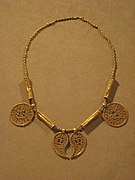
Gold Ancient Byzantine Necklace with Pendants

Gold and Glass Vandal necklace, c. AD 300
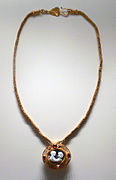
Necklace with Relief Pendant

Silver necklace, c. AD 600-650

Frankish Glass Bead Necklace

Byzantine Christian cross necklace

Byzantine Christian cross necklace

Gold and Platinum Necklace

German Metal Necklace
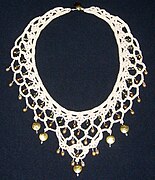
Necklace made from crochet lace, pearls, and sterling silver.

Gold and Platinum French Necklace

Glass Necklace
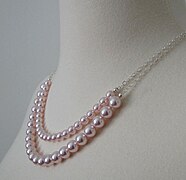
Rosaline Pearl Necklace

Dirce Repossi White Gold and Diamonds Necklace
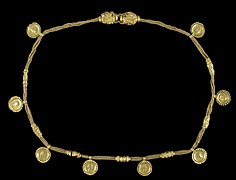
Gold Roman Necklace with Pendant Coins and Braided Chain- Walters 571600

Uranium glass necklace, circa 1940/1950. Uranium glass glows bright green under ultraviolet light.
Other neck uses[]

Non-jewellery items are also used similar to a necklace to be worn on a neck, for example lanyards holding badges and cards.
See also[]
- Cross necklace
- Choker
- Collar
- Figaro chain
- Jewellery chain
- Livery collar
- Locket
- Love beads
- Pendant
- Torc
- Usekh collar
Further reading[]
- Jewelry 7,000 Years ed. Hugh Tait. ISBN 0-8109-8103-3.
- Jewelry Through the Ages by Guido Gregorietti. ISBN 0-8281-0007-1.
- 20,000 Years of Fashion: The History of Costume and Personal Adornment by Francois Boucher. ISBN 0-8109-1693-2.
References[]
- ^ Davenport, Cyril (1902). "Journal of the Society for Arts, Vol. 50, no. 2595". The Journal of the Society of Arts. 50 (2595): 769–780. doi:10.2307/41335652. JSTOR 41335652.
- ^ Gerlach, Martin (1971). Primitive and Folk Jewelry. New York: Dover Publications. ISBN 0-486-22747-2.
- ^ Jump up to: a b c d e f g h i j k l m n o p q r s t u v Bigelow, Marybelle (1979). Fashion in History. Minneapolis, Minnesota: Burgess Publishing Company. ISBN 0-8087-2800-8.
- ^ "Cylinder seal and modern impression: hunting scene | Work of Art | Heilbrunn Timeline of Art History | The Metropolitan Museum of Art". The Met’s Heilbrunn Timeline of Art History. Retrieved 2017-11-07.
- ^ Jump up to: a b c d e f g h i j k l m n o p q r Tait, Hugh (1986). Jewelry: 7,000 Years. New York: Abradale Press. ISBN 0-8109-8103-3.
- ^ "Model collar of Hapiankhtifi | Work of Art | Heilbrunn Timeline of Art History | The Metropolitan Museum of Art". The Met’s Heilbrunn Timeline of Art History. Retrieved 2017-11-07.
- ^ "Necklace of Gold Ball Beads | Work of Art | Heilbrunn Timeline of Art History | The Metropolitan Museum of Art". The Met’s Heilbrunn Timeline of Art History. Retrieved 2017-11-07.
- ^ Patch, Author: Diana Craig. "Egyptian Amulets | Essay | Heilbrunn Timeline of Art History | The Metropolitan Museum of Art". The Met’s Heilbrunn Timeline of Art History. Retrieved 2017-11-07.
- ^ Jump up to: a b Lightfoot, Author: Christopher. "Luxury Arts of Rome | Essay | Heilbrunn Timeline of Art History | The Metropolitan Museum of Art". The Met’s Heilbrunn Timeline of Art History. Retrieved 2017-11-07.
- ^ Jump up to: a b c d e f g h i j k Gregorietti, Guido (1969). Jewelry Through the Ages. New York: American Heritage. ISBN 0-8281-0007-1.
- ^ "Pendant in the Form of Neptune and a Sea Monster | Work of Art | Heilbrunn Timeline of Art History | The Metropolitan Museum of Art". The Met’s Heilbrunn Timeline of Art History. Retrieved 2017-11-08.
- ^ "Necklace | Work of Art | Heilbrunn Timeline of Art History | The Metropolitan Museum of Art". The Met’s Heilbrunn Timeline of Art History. Retrieved 2017-11-09.
- ^ "Parure: tiara, necklace, and brooch | Luigi Saulini, John Gibson | 40.20.55a-c | Work of Art | Heilbrunn Timeline of Art History | The Metropolitan Museum of Art". The Met’s Heilbrunn Timeline of Art History. Retrieved 2017-11-08.
- ^ Trans, Jeppe (9 August 2020). "Fears Indigenous Tasmanian necklaces could become lost art". ABC News. Retrieved 11 August 2020.
- ^ Greeno, Aunty Lolo (26 May 2020). "Tasmanian Aboriginal shell necklaces". The Australian Museum. Retrieved 12 August 2020.
- ^ Garrett, Valery M. (2007). Chinese dress : from the Qing Dynasty to the Present. Tokyo: Tuttle Pub. ISBN 978-0-8048-3663-0. OCLC 154701513.
- ^ "Necklace Length Guide". Viya Crafts. 20 May 2020. Retrieved 12 August 2020.
- Necklaces






